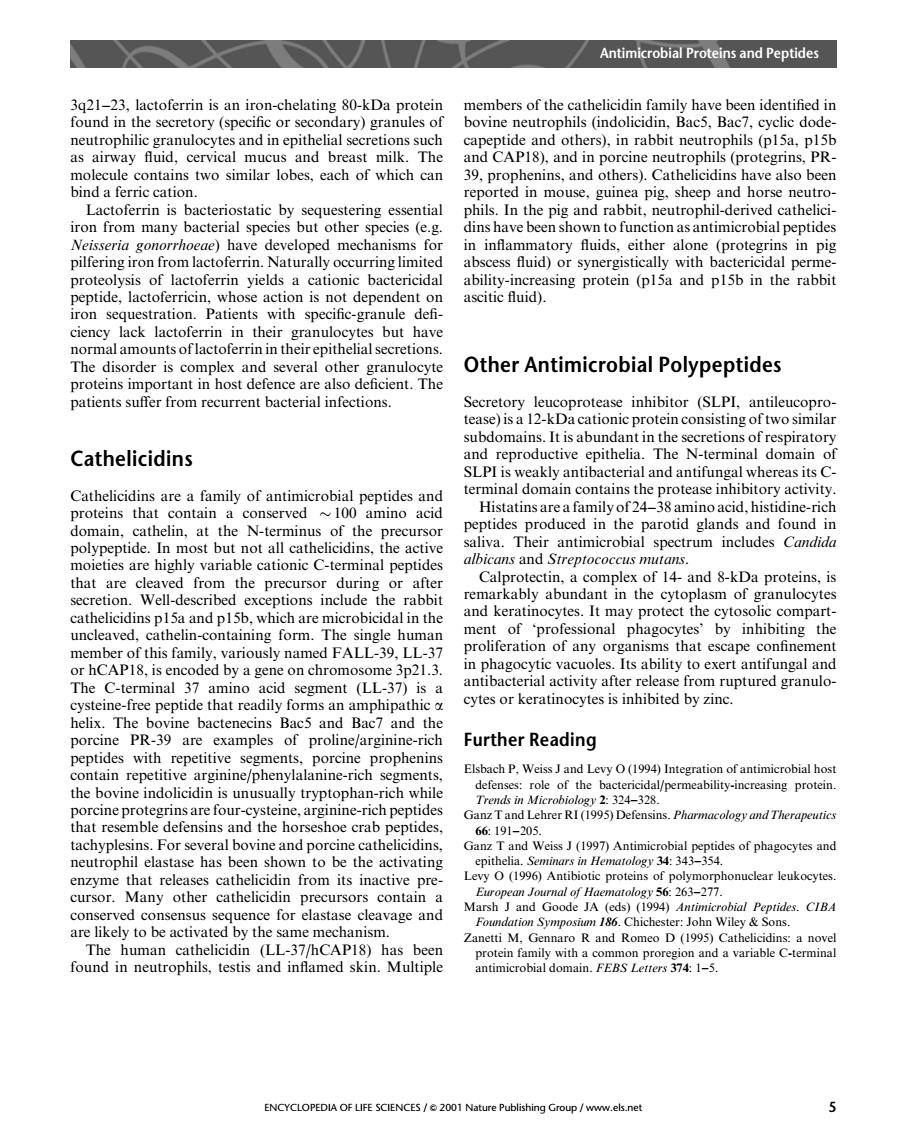正在加载图片...

Antimicrobial Proteins and Peptides 3g21-23.lactoferrin is an iron-chelating 80-kDa protein members of the cathelicidin family have been identified in found in the secretory(specific or secondary)granules of bovine neutrophils (indolicidin,Bac5,Bac7,cyclic dode 9. have also bind a ferric cation. reported in mouse,guinea pig,sheep and horse neutro Lactoferrin is bacteriostatic by sequestering essential phils.In the pig and rabbit,neutrophil-derived cathelici iron from many bacterial species but other species (e.g dins have been shown to fur tion as antimicrobial peptide proteolysis of lactoferrin yields a cationic bactericidal ability-increasing protein (pl5a and plsb in the rabbit peptide,lactofe ieh ascitic fluid). lack with specific-granu The disorder is complex and several other granulocyte Other Antimicrobial Polypeptides proteins important in host defence are also deficient.The patients suffer from recurrent bacterial infections. cons It isa Cathelicidins and reproductive epithelia.The N-terminal domain o Cathelicidins terminal domn the proteere domain,cathelin,at the N-terminus of arouid glands and found in the precursor bunotallcathcticidinsiheacties albicans and Streptococcus mutans Calprotectin,a comp of 14-and 8-kDa proteins, secretion.Well-described x d ke It may cathelicidins pl5a and pl5b,which are microbicidal in the ment of professional phagocytes'by inhibiting the containing form 2 proliferation of any organisms that escape confinemen CAP18.is 1 n phagocyt cuoles.Its ability to exert The C.terminal 37 amino acid segment LL37)is a anifnealao uptured gran ratin cysteine-free peptide that readily forms an mphipathic o helix. bactene is Bacs and Bac? and the are exam prol /argini Further Reading the bovine indolicidin is unusually tryptophan-rich while protcin. 6191-205 Lepithet onuclear leukocyte precursors y56:263-27. are likely to b ivage and The human cathelicidin (LL-37/hCAP18)has beer found in neutrophils,testis and inflamed skin.Multiple antimicrobial domain.F Leer. Publishing Group www.els.ne 53q21–23, lactoferrin is an iron-chelating 80-kDa protein found in the secretory (specific or secondary) granules of neutrophilic granulocytes and in epithelial secretions such as airway fluid, cervical mucus and breast milk. The molecule contains two similar lobes, each of which can bind a ferric cation. Lactoferrin is bacteriostatic by sequestering essential iron from many bacterial species but other species (e.g. Neisseria gonorrhoeae) have developed mechanisms for pilfering iron from lactoferrin. Naturally occurring limited proteolysis of lactoferrin yields a cationic bactericidal peptide, lactoferricin, whose action is not dependent on iron sequestration. Patients with specific-granule defi- ciency lack lactoferrin in their granulocytes but have normal amounts of lactoferrin in their epithelial secretions. The disorder is complex and several other granulocyte proteins important in host defence are also deficient. The patients suffer from recurrent bacterial infections. Cathelicidins Cathelicidins are a family of antimicrobial peptides and proteins that contain a conserved 100 amino acid domain, cathelin, at the N-terminus of the precursor polypeptide. In most but not all cathelicidins, the active moieties are highly variable cationic C-terminal peptides that are cleaved from the precursor during or after secretion. Well-described exceptions include the rabbit cathelicidins p15a and p15b, which are microbicidal in the uncleaved, cathelin-containing form. The single human member of this family, variously named FALL-39, LL-37 or hCAP18, is encoded by a gene on chromosome 3p21.3. The C-terminal 37 amino acid segment (LL-37) is a cysteine-free peptide that readily forms an amphipathic a helix. The bovine bactenecins Bac5 and Bac7 and the porcine PR-39 are examples of proline/arginine-rich peptides with repetitive segments, porcine prophenins contain repetitive arginine/phenylalanine-rich segments, the bovine indolicidin is unusually tryptophan-rich while porcine protegrins are four-cysteine, arginine-rich peptides that resemble defensins and the horseshoe crab peptides, tachyplesins. For several bovine and porcine cathelicidins, neutrophil elastase has been shown to be the activating enzyme that releases cathelicidin from its inactive precursor. Many other cathelicidin precursors contain a conserved consensus sequence for elastase cleavage and are likely to be activated by the same mechanism. The human cathelicidin (LL-37/hCAP18) has been found in neutrophils, testis and inflamed skin. Multiple members of the cathelicidin family have been identified in bovine neutrophils (indolicidin, Bac5, Bac7, cyclic dodecapeptide and others), in rabbit neutrophils (p15a, p15b and CAP18), and in porcine neutrophils (protegrins, PR- 39, prophenins, and others). Cathelicidins have also been reported in mouse, guinea pig, sheep and horse neutrophils. In the pig and rabbit, neutrophil-derived cathelicidins have been shown to function as antimicrobial peptides in inflammatory fluids, either alone (protegrins in pig abscess fluid) or synergistically with bactericidal permeability-increasing protein (p15a and p15b in the rabbit ascitic fluid). Other Antimicrobial Polypeptides Secretory leucoprotease inhibitor (SLPI, antileucoprotease) is a 12-kDa cationic protein consisting of two similar subdomains. It is abundant in the secretions of respiratory and reproductive epithelia. The N-terminal domain of SLPI is weakly antibacterial and antifungal whereas its Cterminal domain contains the protease inhibitory activity. Histatins are a family of 24–38 amino acid, histidine-rich peptides produced in the parotid glands and found in saliva. Their antimicrobial spectrum includes Candida albicans and Streptococcus mutans. Calprotectin, a complex of 14- and 8-kDa proteins, is remarkably abundant in the cytoplasm of granulocytes and keratinocytes. It may protect the cytosolic compartment of ‘professional phagocytes’ by inhibiting the proliferation of any organisms that escape confinement in phagocytic vacuoles. Its ability to exert antifungal and antibacterial activity after release from ruptured granulocytes or keratinocytes is inhibited by zinc. Further Reading Elsbach P, Weiss J and Levy O (1994) Integration of antimicrobial host defenses: role of the bactericidal/permeability-increasing protein. Trends in Microbiology 2: 324–328. Ganz T and Lehrer RI (1995) Defensins. Pharmacology and Therapeutics 66: 191–205. Ganz T and Weiss J (1997) Antimicrobial peptides of phagocytes and epithelia. Seminars in Hematology 34: 343–354. Levy O (1996) Antibiotic proteins of polymorphonuclear leukocytes. European Journal of Haematology 56: 263–277. Marsh J and Goode JA (eds) (1994) Antimicrobial Peptides. CIBA Foundation Symposium 186. Chichester: John Wiley & Sons. Zanetti M, Gennaro R and Romeo D (1995) Cathelicidins: a novel protein family with a common proregion and a variable C-terminal antimicrobial domain. FEBS Letters 374: 1–5. Antimicrobial Proteins and Peptides ENCYCLOPEDIA OF LIFE SCIENCES / & 2001 Nature Publishing Group / www.els.net 5